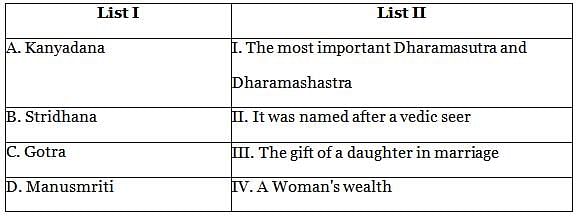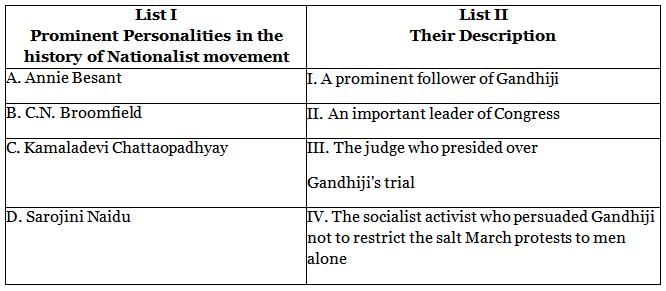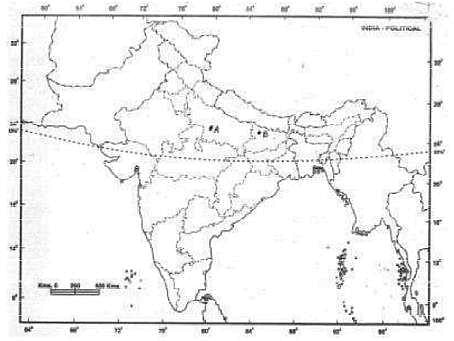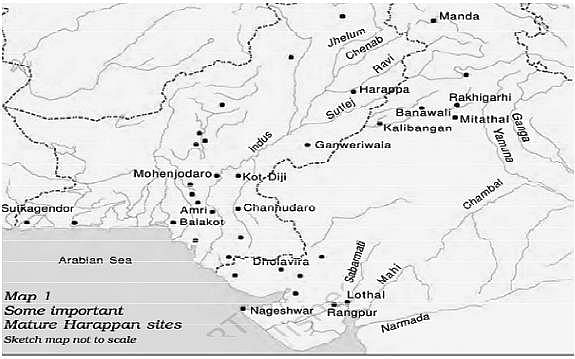CUET History Previous Year Solved Paper 5 (10 August 2022 Slot-1) - Humanities/Arts MCQ
30 Questions MCQ Test - CUET History Previous Year Solved Paper 5 (10 August 2022 Slot-1)
The court poet of Samudragupta who composed Prayaga Prashasti (also known as the Allahabad Pillar Inscription) in Sanskrit was:
The marriage practice within a unit-a kin group, caste or a group living in the same locality, is known as:-
| 1 Crore+ students have signed up on EduRev. Have you? Download the App |
Tamil Sangam literature refers to slaves as ______.
In 1857 the sepoys of Meerut appealed to the old Mughal emperor to accept the leadership of the revolt because:
Match the placed List II from the excav ated objects given in List I

Choose the correct answer from the options given below:
Arrange the following mature harappan sites f rom east to west.
A. Harappa
B. Suktagendor
C. Amri
D. Kalibangan
E. Chahudaro
Choose the correct answer from the option given below:
The Rajasuya and Ashwamedha of the later Vedic Period were:
The Upanishads showed the curiosity of people about:
A. The meaning of life
B. The possibility of life after death
C. The rebirth due to past actions
D. The nature of the ultimate reality
E. The significance of the Sacrificial tradition
Choose the correct answer from the options given below:
Who was the traveler whose account described Delhi as a vast city, with a great population, the largest in India: -
The Vijaynagara kings claimed that they ruled on behalf of the Hindu God:-
Match the List I with List II and choose the correct answer.

Choose the correct answer from the options given below:
Who among the following leaders gave emphasis on 'Hindustani' for the national language?
Arrange the following ev ents in chronological order:
A. The cabinet mission announces its constitutional scheme.
B. The labour Governm ent comes into power in Britain.
C. The Constitution is signed
D. The Constituent Assembly begins its sessions
E. Partition of India
Choose the correct answer from the options given below:
Match List I with List II

Choose the correct answer from the options given below:
Select the correct arrangem ent of the following as per the ascending sequence of occurrence
A. Quit India Movement
B. Royal Indian Navy Rising
C. The great Calcutta Killings of August 1946
D. Independence day of India
Choose the correct answer from the options given below:
Whose constitutional status remained ambiguous at the time of Independence?
In Bengal, A Rich Asami meant _______.
In which year Babur defeated Ibrahim Lodhi, the Delhi Sultan, at Panipat in _______ and became the first Mughal emperor:
Select the correct arrangement of the following dynasties in the sequence of their occurrence
A. Tuluva dynasty
B. Aravidu
C. Sangama dynasty
D. Saluvas
Choose the correct answer from the options given below:
Identify the given figure and tick the correct one:

The combined armies of which States routed the army of Rama Rai in 1565?
A. Golkonda, Ahmednagar, Bidar
B. Ahmednagar, Berar, Bijapur
C. Bijapur, Ahmedanagar, Bidar
D. Bijapur, Ahmednagar, Golkonda
Choose the correct answer from the options given below:
The Mughal empire was among the large territorial empires in Asia that had managed to consolidate power and resources during the sixteenth and seventeenth centuries. Which of the following empires was not enjoying the same power but positioned similar to the Mughals?
Select the correct match of the term with their meanings.

Choose the correct answer from the options given below:
Which of the following was built by Akbar to commemorate his conquest of Khandesh in Gujrat?
Select the correct match of List I and List II

Choose the correct answer from the options given below:
Directions: Answer the questions on the basis of given map.

Identify the place marked as 'A' in the given political map of India- One of the of the Principal centre of Revolt of 1857 led by Nana Sahib
Directions: Answer the questions on the basis of given map.

Identify the place marked as 'B' from the given options and clueMahatma Gandhi's campaign for the peasants security of tenure as well as freedom to cultivate the crops of their choice
The people were annoyed by the British because:
A. British land revenue settlements had dispossessed land holders both big and small
B. Foreign commerce had driven artisans and weavers to ruin.
C. The firangi were accused of destroying a way of life that was familiar and cherished.
D. The British rule had developed India economically as well as educationally.
E. The British were biased against the Hindus
Choose the correct answer from the options given below:
After loosing the battle of Kannauj in 1540 where did Humayun take refuge in the court of:
Under Sulh- i- kul , all religion had freedom of expression but on certain condition. Identify the condition.


















